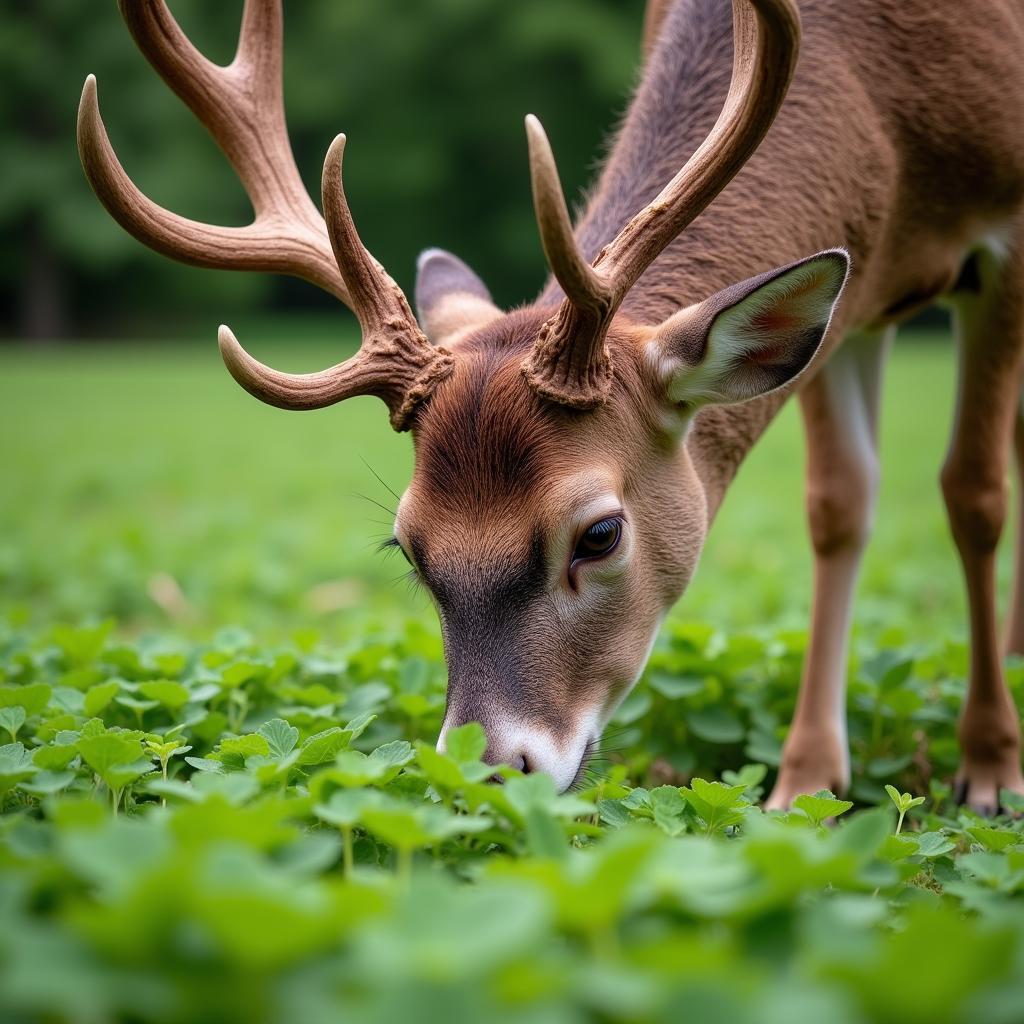Clover Deer Food Plots are a popular choice among hunters and wildlife enthusiasts for attracting whitetail deer. These plots offer a nutritious and attractive food source that can keep deer coming back for more. Planting and maintaining a successful clover food plot requires some planning and effort, but the rewards are well worth it. Let’s delve into the world of clover food plots and discover how to maximize their effectiveness. clover food plot
Why Choose Clover for Deer Food Plots?
Clover is a highly palatable and nutritious forage for deer, providing essential proteins, vitamins, and minerals crucial for their growth and antler development. Several clover varieties are suitable for food plots, each with its advantages. White clover, for example, is known for its high protein content and tolerance to grazing pressure. Red clover offers excellent drought tolerance and attracts a variety of pollinators. Choosing the right clover variety depends on your specific location, soil type, and climate. What’s the best food plot for both deer and turkey, you might wonder? Consider a clover and chicory mix!
Establishing Your Clover Deer Food Plot
Preparing the soil properly is crucial for successful clover establishment. Soil testing is recommended to determine the pH and nutrient levels, allowing you to amend the soil accordingly. A well-drained soil with a pH between 6.0 and 7.0 is ideal for most clover varieties. Next, clear the area of existing vegetation and till the soil to create a seedbed. Broadcasting or drilling the clover seed is the most common planting method. The ideal seeding rate depends on the clover variety and planting method.
Maintaining Your Clover Food Plot
Once your clover food plot is established, regular maintenance is essential to ensure its longevity and productivity. This includes controlling weeds, fertilizing as needed, and mowing or clipping to promote new growth. Overgrazing can also be detrimental to the plot, so consider implementing rotational grazing or other management strategies. Do you know when to cut clover food plots? Timing is key to maximize regrowth and maintain its nutritional value.
Choosing the Right Clover Seed
Selecting the appropriate clover seed is critical for the success of your food plot. Consider factors like your region’s climate, soil type, and deer preferences. clover seed food plot offers valuable insights into selecting the best clover seed for your specific needs. Different clover varieties thrive in different conditions, so choosing the right one is essential.
 Deer grazing in a lush clover food plot
Deer grazing in a lush clover food plot
Chicory: A Beneficial Companion Plant
Consider adding chicory to your clover food plot. Chicory is a deep-rooted perennial that attracts deer and provides a valuable forage source, especially during drier periods. chicory food plot offers more information on the benefits of this companion plant. It can also help improve soil health and enhance the overall productivity of your food plot.
The Benefits of a Thriving Clover Deer Food Plot
A well-maintained clover food plot offers numerous benefits beyond attracting deer. It can improve soil health, provide habitat for other wildlife, and enhance the overall beauty of your property. By providing a consistent food source, you can help improve the local deer population’s health and antler development. For information on when to cut your clover plot for optimal growth, check out when to cut clover food plots.
 Healthy deer thriving in a clover food plot
Healthy deer thriving in a clover food plot
Conclusion
Clover deer food plots are a valuable tool for attracting and supporting healthy deer populations. By carefully selecting the right clover variety, preparing the soil properly, and implementing a regular maintenance plan, you can create a thriving food plot that will benefit deer and enhance your hunting experience. Remember, a successful clover food plot requires ongoing effort, but the rewards are well worth the investment.
FAQ
- What type of clover is best for deer? White clover and red clover are both popular choices.
- When should I plant clover for deer? Fall is generally the best time to plant clover.
- How do I maintain a clover food plot? Regular weeding, fertilization, and mowing are essential.
- How much clover seed do I need per acre? The seeding rate depends on the clover variety and planting method.
- Can I plant clover with other forages? Yes, chicory is a beneficial companion plant for clover.
- Why are my clover food plots not thriving? Several factors, including soil pH, weed pressure, and overgrazing, can impact clover growth.
- What are the best food plots for deer and turkey? Clover is an excellent choice for both, especially when combined with chicory.
For more helpful tips and information, visit our website for articles on best food plot for deer and turkey.
Need help with your food plot? Contact us! Phone: 02437655121, Email: minacones@gmail.com or visit us at 3PGH+8R9, ĐT70A, thôn Trung, Bắc Từ Liêm, Hà Nội, Việt Nam. We have a 24/7 customer service team.